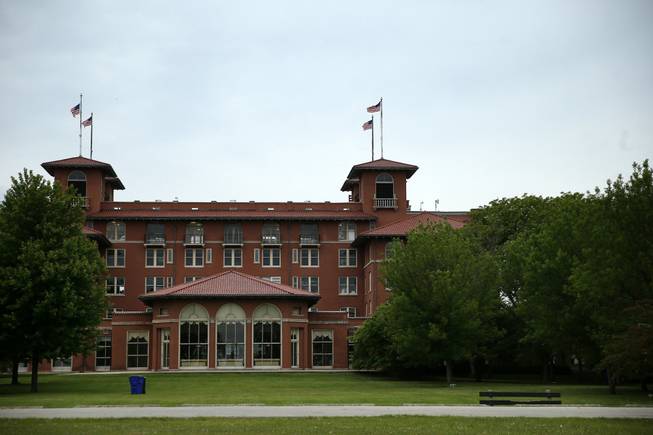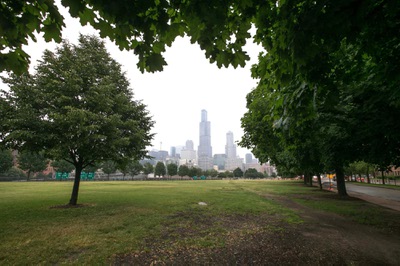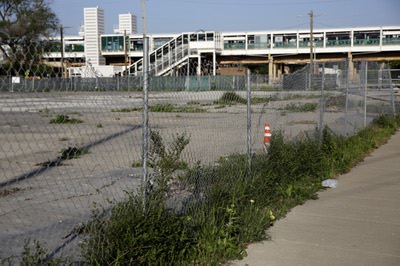
Anthony Souffle / Chicago Tribune / MCT
The South Shore Cultural Center on Wednesday, June 10, 2014, in Chicago. The northeast section of the property that the South Shore Golf Course sits on is being considered as one of three possible spots for the Barack Obama Presidential Library.
Thursday, June 12, 2014 | midnight
The South Side lakefront jewel where Barack and Michelle Obama held their wedding reception vs. a rare, open downtown field set against Chicago's majestic mountain range of skyscrapers.
The home of the 1893 world's fair, near where Frederick Law Olmsted dredged his intricate lagoons, vs. parking lots on a west-side medical campus near the Polk Street Pink Line station.
Or vacant blocks near the University of Chicago that back up to the Garfield Green Line station vs. incorporating public transit, a Metra station, into the building itself on a far South Side college campus.
These are just a few of the preliminary offerings area universities plan to present to the president, the first lady and the few confidants helping them as they begin to weigh where to locate the Obama presidential library and museum, according to multiple sources.
Although Chicago is considered the front-runner, other bidders — from New York City's Columbia University to the University of Hawaii and a private Chicago developer — plan to submit offerings ahead of a Monday deadline for initial proposals set by The Barack Obama Foundation.
The University of Chicago, according to sources, will focus its recommendations on three South Side areas: Garfield Boulevard and Martin Luther King Jr. Drive, adjacent to the Garfield Green Line stop; the west side of Jackson Park between Cornell Avenue and Stony Island Avenue near Hyde Park Academy High School; and the South Shore Cultural Center on Lake Michigan.
Meanwhile, the University of Illinois at Chicago and Chicago State University, as well as developer Dan McCaffery, are publicly discussing their offerings.

A new proposed site of the Obama Presidential Library, on the UIC Campus, just south of the Eisenhower Expressway, is seen, June 10, 2014. Harrison on the South, the Eisenhower on the North, Halsted on the East and Morgan Street on the West bound it. The view is looking eastward towards the city skyline.
UIC will offer the most central and accessible site of them all: Harrison Field at the corner of Harrison and Halsted streets, on the southwest side of the Circle Interchange and steps from the UIC-Halsted Blue Line station. Any building erected there would offer sweeping views of the downtown skyline.
"You can take the Blue Line and hop off at the UIC-Halsted stop, and you're right there," UIC spokesman Bill Burton said. "It's literally in the shadow of Willis Tower, and all the expressways come together there."
An alternative UIC site, in the Illinois Medical District at Ashland Avenue and Taylor Street, would include two parcels on the north and south sides of Taylor. It would back up to the university's Molecular Biology Research Building, a $58 million, 230,000-square-foot structure, which opened in 1995.
Chicago State University will offer two sites. One, on the northeast corner of campus at 95th Street and South Cottage Grove, would include a bridge linking the campus with two parcels on Cottage Grove. The plan would relocate the 95th Street Metra Electric District station to the inside of the Obama library. The second option would see the library on about 19.3 acres of land on the south end of campus.
Both sites would take advantage of the proposed Red Line extension, a massive undertaking by the Chicago Transit Authority to extend the line south to 130th Street. There is currently no money available to build the extension, and the environmental assessment will not be finished before 2016. Still, Chicago State's plan calls for an additional Red Line stop at the university — at East 99th Street and King Drive.
"This is an example of how the presidential library can spur economic development," said Chicago State spokesman Tom Wogan. "If you're going to do a major project like the Red Line extension, this becomes a major opportunity to inject development into the plan."
McCaffery, meanwhile, said he wants the library to anchor his $4 billion retail and residential development planned on the old U.S. Steel South Works site, located south of the South Shore Cultural Center along the lakefront.
The University of Chicago rebuffed McCaffery's efforts to get his development included in the university's proposal and now will make an independent bid, he said. The lack of a university sponsor will hurt his chances, as one criteria of the library would be that it facilitates scholarly research.
"It extends our economic boundary, and it's beautiful," McCaffery said of the massive swath of undeveloped lakefront land.
Another undeveloped yet far more central location for a presidential library would be the old Michael Reese Hospital site in Bronzeville. At 48 acres, the large site would take an estimated $22 million to remediate and up to $125 million to lay infrastructure, such as roads and a pedestrian bridge over the adjacent Metra tracks, according to a city source.
Paula Robinson, president of the Black Metropolis National Heritage Area Commission, said her group is moving ahead with their bid for the Obama Library on the Reese site. Robinson's group, like McCaffrey, is proceeding without university backing.
Meanwhile, the University of Hawaii, where the president grew up, has said it wants to build the library on oceanfront property in Kakaako, a commercial and retail district of Honolulu between Ala Moana and Waikiki. It remains to be seen what parcels Columbia University, the president's undergraduate alma mater, will offer, with a report pinning the site at just north of its Morningside Heights campus.
"I think Columbia University is a perfect place for President Obama's Museum, and I'm not sure if they're going to have one facility or multiple facilities, but I hope that we get at least one piece if they do break it up into pieces," New York Mayor Bill de Blasio said at a news conference last week. "I certainly have made an effort. I've certainly let the Obama team know that we are excited about the idea; we would do anything we can to be helpful to it."
In an emailed statement, U of C confirmed it was exploring three South Side locations. University spokesman Jeremy Manier declined to elaborate further, but sources familiar with the school's proposal identified the Garfield, Jackson Park and South Shore sites. He emphasized that the university was flexible and open to the first family's ideas.
"Within those (three) areas there are multiple options and many potential variations," Manier said in an email. "The decision of how to proceed on potential locations will be up to the Foundation; we will be responsive and open to other ideas that could emerge from this process."
And most of that process will unfold in secret as the nonprofit foundation, led by Obama friend and Chicago private equity executive Martin Nesbitt, has said it will not release bidders' proposals. After this round of bids, the field of candidates will be narrowed, and the foundation will request detailed proposals from finalists. The foundation has not yet decided whether to release the identities of the finalists.
The Obamas are not required to accept any proposed site and could push for an alternative not yet identified. A final decision is not expected until 2015.
A lengthy article in Politico this month fueled speculation that the president would select Chicago as the library site — but that the first couple may move to New York City after his term ends in January 2017.
Michelle Obama was born in Chicago and raised in the South Shore neighborhood, while the president built his political following here, beginning as a community organizer on the South Side before attending Harvard Law School. He also taught at the University of Chicago's law school from 1992 until his election to the U.S. Senate 2004.
The foundation itself has called for the future library to be an economic engine. Of the U of C's three options, the site adjacent to the Green Line and facing Washington Park would most fulfill that requirement. The area is surrounded by vacant lots and abandoned homes.
Meanwhile, nothing but beauty can be seen from the lawn of the South Shore Cultural Center, located about 4.5 miles southeast of the Green Line stop, where the Obamas held their wedding reception in 1992. (Mayor Rahm Emanuel and Amy Rule were married there.)
Originally an exclusive country club, a "country" sister to the urban Chicago Athletic Club, it excluded black and Jewish members. Membership peaked in the 1950s but, by the mid-1970s, it had gone out of business. The Chicago Park District bought the property in 1975 and kept its golf course.
Designed by the firm Marshall and Fox, the architects of the Drake and Blackstone hotels, the grand and gated building is dressed in a rusty, red stucco and designed in a Mediterranean-Revival-style, common in California and Florida, but unusual for Chicago.
Its ballroom has the elegant aura of one of Captain von Trapp's stately rooms in the "Sound of Music." Yet, upon closer inspection, the curtains are stained. The wood windows are rotting. And at lunchtime on a sunny Monday afternoon, its Parrot Cage restaurant, home to a culinary school, was closed, and the doors to the solarium and ballrooms locked.
The building is landmarked, meaning it cannot be demolished or substantially altered. Instead, the library foundation or the Chicago Park District would need to restore it, and the foundation would need to build Obama's structure nearby. The only unused space there now is a stretch of grass and trees to the north of the cultural center between Lake Michigan and the fairways, the northern point of which offers picturesque views of Chicago's skyline.
Still, the challenge is that but for the South Shore Metra stop across the street from the center's gatehouse and three bus routes that stop there, the site is rather inaccessible via public transit. The same is true for another of U of C's offerings, the west side of Jackson Park near Hyde Park Academy High School.
The vision here would be to make a Museum Campus South by encouraging connections — both programmatic and structural — between the library and the Museum of Science and Industry to the north.
The World's Columbia Exposition of 1893 drew more than 25.8 million visitors to Jackson Park during its six-month run. The museum is the only major building remaining from that event, which debuted the Ferris wheel, the brownie and the zipper, among other inventions.
But even the museum required extensive renovations, and only some of the landscape remains, such as the hills, which are man-made and constructed from the debris workers dug up to open the lagoons. The library would be just to the southwest of the lagoons surrounding Olmsted's "Wooded Island," on which sat a Japanese garden created for the world's fair.
Still, the site's immediate environs would be a football field and tennis courts, some not so well kept. And the site is enough of a walk from the 63rd Street Metra station to be unpleasant in winter.
However, the University of Chicago already has four subsidized bus routes that connect spots on the Hyde Park campus. The Museum of Science and Industry also subsidizes the No. 10 bus, which takes tourists from North Michigan Avenue to the museum. Such customized routes could be an option for the library, should the Obamas choose a site not on the 'L.'
No such additions or extensions would be necessary for UIC's offerings.
Harrison Field, considered a gem of the Near West Side, has long been the site of the popular "Spark in the Park" music festival held for new students each fall. Located on the edge of Greektown, it sits directly on the Blue Line and several bus lines, and has a Greyhound bus station and rail hubs a block away. An adjacent parking lot would also be part of the footprint of the site, Burton said.
In addition, he said, the university is sending a contingent of students to Washington to meet Monday with members of Chicago's congressional delegation and others who have a stake in seeing the library built in Chicago.
RedEye’s Tracy Swartz contributed to this report.


Join the Discussion:
Check this out for a full explanation of our conversion to the LiveFyre commenting system and instructions on how to sign up for an account.
Full comments policy